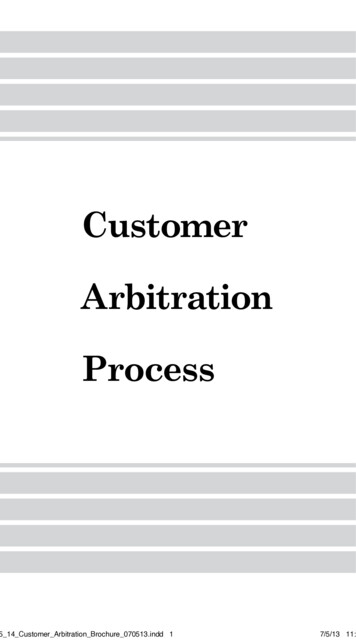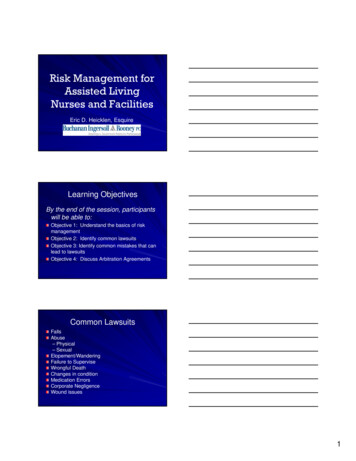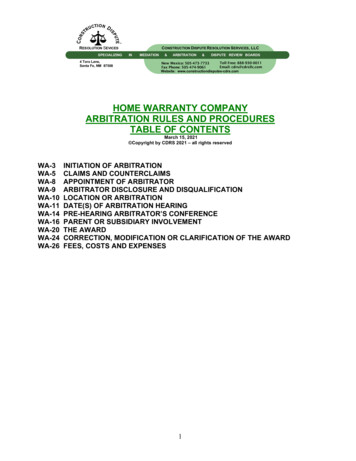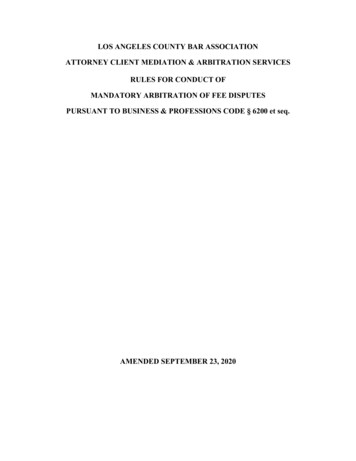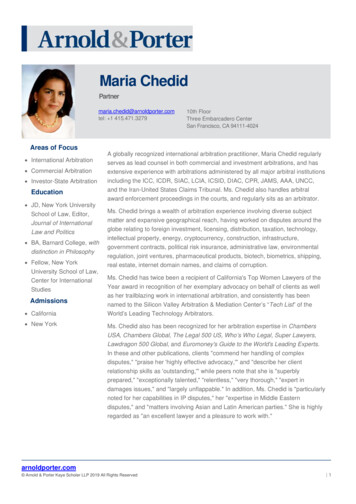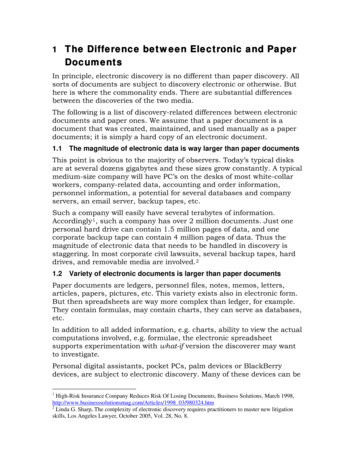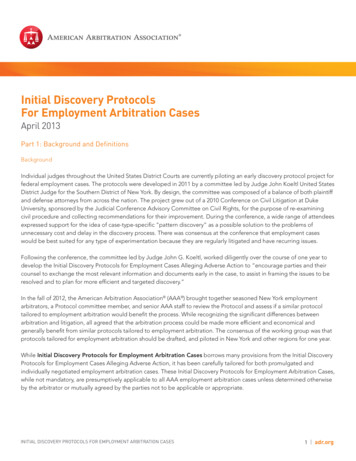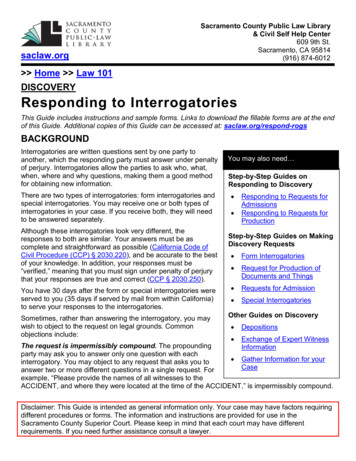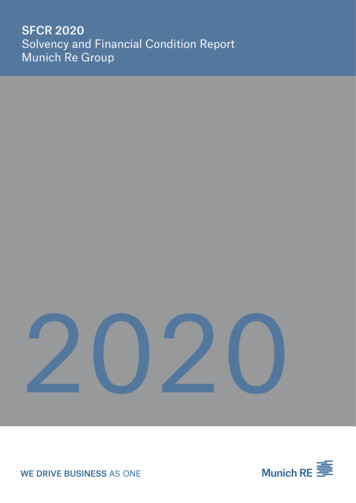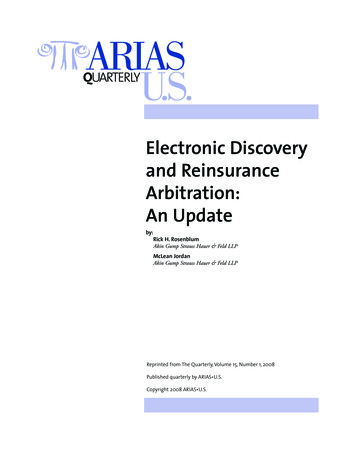
Transcription
Rosenblum4/16/082:19 PMPage FC1Electronic Discoveryand ReinsuranceArbitration:An Updateby:Rick H. RosenblumAkin Gump Strauss Hauer & Feld LLPMcLean JordanAkin Gump Strauss Hauer & Feld LLPReprinted from The Quarterly, Volume 15, Number 1, 2008Published quarterly by ARIAS U.S.Copyright 2008 ARIAS U.S.
Rosenblum4/16/082:19 PMPage 1ARIAS U.S. QUARTERLY - FIRST QUARTER 2008Electronic Discovery andReinsurance Arbitration: An UpdateRick H. RosenblumMcLean JordanI. Introduction“[T]he rules of discovery must change associety changes, technology increases, andthe virtual ‘distance’ between business andindividuals who interact is shrinking .”1With over ninety percent of all informationcreated today originating in electronicformats2, production and discovery rulesmust evolve to accommodate the advancesin information creation, storage, and sharing.Reinsurance arbitrators are not immunefrom the challenges presented by new anddemanding issues developing from theboom in electronic information. In someways, reinsurance arbitrators faceparticularly vexing electronic discoveryissues, as discovery standards and guidelineswithin the realm of reinsurance are vague, ifthey exist at all . While the U.S. federal courtsdeveloped an initial set of general rulesrelating to e-discovery with the institution ofthe December 1, 2006, amendments to theFederal Rules of Civil Procedure, arbitratorsare frequently free to eschew thosemandates. Rather, reinsurance arbitrationpanel members (as well as parties arguingfor a particular discovery result) may turn toa variety of resources to inform theirdiscretion when determining a discoveryprotocol or a discovery dispute in a givenmatter.This paper, which builds upon an articlepublished in the ARIAS U.S. Quarterly in2006 by Peter R. Chaffetz and Andreas A.Frischknecht entitled Electronic Discovery inArbitration,3 will discuss the majordifferences between paper and electronicallystored information, and e-discovery rulesunder the Federal Arbitration Act and theFederal Rules of Civil Procedure. In addition,we will present updates to the fourteenSedona Principles, reference discoverylanguage common in reinsurance treatiesand contracts, and conclude with anfeatureexample litigation holding letter, which mayprove useful in communicating with thosewho may control potentially discoverableinformation about the scope of their dutiesto preserve that information when litigationor arbitration is imminent or has beeninitiated. Additionally, our appendicesprovide the revised Sedona Principles, ahelpful chart cross referencing e-discoverytopics with the Federal Rules of CivilProcedure and the Sedona Principles, and amodel litigation hold letter.II. How Electronic DocumentProduction is DifferentIn deciding what discovery standards toemploy and how to implement a discoveryprotocol in a given reinsurance dispute, it ishelpful to evaluate some of the keydifferences between paper production and ediscovery. The Sedona Conference WorkingGroup on Electronic Document Retention &Production (“Sedona Conference”), known forits fourteen Sedona Principles4, created a listof six of these differences.5First, the volume of electronically storedinformation available for e-discovery is fargreater than traditional paper documents.6 Asingle large entity can store millions of emails and electronic files each day.7Second, paper documents are more easilydisposed of than electronically storedinformation and files.8 Computer users who“delete” files normally have not actually“destroyed” them; they have been tagged asout of use and may or may not be writtenover at a later time.9 Electronic files maypersist long after a user deletes his or herown file.Third, data stored electronically may changeform automatically as part of the storageprocess.10 Routine manipulation of anelectronic file, such as moving it from onefolder to another, can also change“metadata” within files.11 This metadata, thefourth noted difference between paper andelectronic information storage, is “hidden”Rick H.RosenblumMcLeanJordanIn some ways,reinsurancearbitrators faceparticularly vexingelectronicdiscovery issuesRick H. Rosenblum is a partner at AkinGump Strauss Hauer & Feld LLP,heading the Firm's San Antoniolitigation section. McLean Jordan isan associate in Akin Gump's SanAntonio office. Both practice in theareas of insurance and reinsurancelitigation, counseling, and arbitration,and insurer insolvency.This article is based on a presentationat the ARIAS U.S. Fall Conference,November 1, 2007.
Rosenblum4/16/082:19 PMPage 3ARIAS U.S. QUARTERLY - FIRST QUARTER 2008The December 1,2006 Federal Rulesof Civil Procedureamendments movedelectronically storedinformation onto“equal footing” withtraditional paperdiscovery rules.information about file characteristics such asdate of creation, revision history, andauthorship.12 Metadata’s relevance inreinsurance arbitration proceedings may varydrastically. While metadata may providecrucial information in some claims, in othercases it may provide little materialevidentiary value.13Fifth, electronic information may be uselessindependent of its environmental backdrop.14Often to understand electronic information,one needs to know the context and formatof the material.15 Data storage systems alsoevolve, making “legacy” data stored underolder systems difficult to recover.16Finally, electronic information may bedeposited in many locations, such as harddrives, network servers, and back-up tapes.17However, software allows for quicker andmore sophisticated file searching than couldbe done by individual persons.18These six distinctions show some of thefactors reinsurance arbitrators shouldevaluate when choosing how to proceedwith e-discovery issues. These difference alsobring into sharp focus the economics ofdiscovery, as a party tasked with gatheringelectronically stored information could havean expensive task ahead of itself. The partieswill certainly argue over, and presentevidence about, expense associated withresponding to requests for electronicdiscovery, thus testing the panel to cobbletogether an arrangement that protects theparties abilities to present their respectivecases, protect confidential or privilegedinformation, and avoid unnecessary or undueexpense.This paper will next discuss discovery and ediscovery guidelines available for reinsurancearbitrators.III. Discovery Rules Under theFederal Arbitration ActThe Federal Arbitration Act (“FAA”), enactedin 192519, leaves open many questions aboutthe scope of discovery in arbitration. Thelanguage of the FAA addresses discoveryprocedures only briefly and vaguely. Somemay argue the lack of explicit discovery rulesunder the FAA is itself an expression ofCongressional intent. To the extent the FAAdoes refer to discovery, that mention is foundin Section 7, which provides that “[t]hearbitrators selected . . . may summon inwriting any person to attend before them orany of them as a witness and in a proper caseto bring with him or them any book, record,document, or paper which may be deemedmaterial as evidence in the case.”20While § 7 clearly provides arbitrators theability to summon non-parties and producedocuments at hearings, courts are split as towhether § 7 allows arbitrators to order partiesto produce documents before hearings.21 TheSixth and Eighth Circuits allow arbitrators toissue pre-hearing discovery subpoenas onnon-parties, while the Third and FourthCircuits interpret § 7 as preventing prehearing discovery subpoenas on nonparties.22Although the guidance provided by the FAA isminimal, recent amendments to the FederalRules of Civil Procedure address e-discoveryissues directly.IV. E-Discovery Under theFederal Rules of CivilProcedureThe December 1, 2006 Federal Rules of CivilProcedure amendments moved electronicallystored information onto “equal footing” withtraditional paper discovery rules.23 Rule16(b)(5) provides that scheduling ordersshould include provisions for e-discovery anddisclosure, in an attempt to remind courts toaddress e-discovery matters early inlitigation.24 Similarly, Rule 26(f) requiresparties to discuss e-discovery issues at leasttwenty-one days before the schedulingconference.25 Comments to Rule 26(f) alsosuggest that parties familiarize themselveswith information systems involved inproduction and develop a discovery planaccordingly, paying particular attention todata preservation issues.26The Rules also allow parties to test or sampleelectronically stored information.27 The Rulespermit parties to request different forms ofproduction for different document types,acknowledging that producing allelectronically stored information in oneformat could prove unnecessarily costly.28However, if the form of production is notspecifically indicated, the responding partymust produce the information in a“reasonably usable” manner or in the form itis usually maintained.29E-discovery is narrowed under Rule26(b)(2)(B), which limits production of
Rosenblum4/16/082:19 PMPage 5ARIAS U.S. QUARTERLY - FIRST QUARTER 2008materials “not reasonably accessiblebecause of undue burden or cost.”30However, the court may neverthelessorder discovery if good cause is shown.31The amendments allow the court tobalance the costs and burdensassociated with some e-discoveryagainst the potential benefits ofdiscovery.32Finally, while sanctions may be imposedfor e-discovery violations, Rule 37(f)prohibits sanctioning of parties who failto provide electronically storedinformation as a result of routine, goodfaith system operations.33 This Ruleprotects destruction of evidence thatoccurs without culpable conduct.34 Ofcourse, there is no specific analog underthe FAA or elsewhere to Rule 37’sauthorization of discovery sanctions,and there are no requirements thatparties certify they have complied withand/or responded to discovery requestsin good faith. Still, a panel has inherentauthority to enforce its orders.Thus, the amendments to the FederalRules of Civil Procedure target ediscovery issues directly. But even withthese recent changes, many e-discoveryprocedural questions remainunanswered. For the past four years,courts have used the Sedona Principlesto fill in some of the gaps.V. Sedona PrinciplesThe original Sedona Principles weredeveloped in early 2003 by a group ofattorneys and practitioners familiarwith e-discovery matters who wereconcerned that a system developed forpaper discovery would not translate toe-discovery.35 The fourteen SedonaPrinciples were “‘intended tocomplement the Federal Rules of CivilProcedure, which provide[d] only broadstandards, by establishing guidelinesspecifically tailored to address theunique challenges posed by electronicdocument production.’”36 “The rules donot answer many of the most vexingquestions judges and litigants face.They do not govern a litigant’s conductbefore suit is filed, nor do they providesubstantive rules of law in suchimportant areas as the duty ofpreservation or the waiver of attorney-37client privilege.” The Sedona Principlesprovide guidance to attorneys facing ediscovery issues, but maintain enoughflexibility to adjust to exceptionalcircumstances.38Since Mr. Chaffetz’s and Mr.Frischknecht’s article was published inthe ARIAS U.S. Quarterly, the SedonaConference has revised the originalfourteen Sedona Principles. The SecondEdition Sedona Principles are provided inAppendix A. New language found in theSecond Edition Sedona Principlesreflects both the changes in the FederalRules of Civil Procedure and theevolution of technology itself.39 Rulestwelve (metadata) and fourteen(sanctions) have been substantiallyrevised.In choosing e-discovery guidelines forreinsurance arbitrations, it is helpful tounderstand the relationship betweenthe Sedona Principles and the FederalRules of Civil Procedure. The originalSedona Principles influenced bothacademic and judicial responses to ediscovery issues. As one court noted in2005,“ . . . neither the federal rules norcase law provides sufficient guidance onthe production of metadata, [so] theCourt next turns to materials issued bythe Sedona Conference . . .The Courtfinds two of the Sedona Principles . . .particularly helpful in determiningwhether Defendant was justified inscrubbing the metadata from theelectronic spreadsheets.”40In turn, after the Federal Rules of CivilProcedure e-discovery amendments, theSecond Edition Sedona Principles wereshaped by the language of the newrules.41 Today, even with the amendedrules, courts reference the SedonaPrinciples as a “leading resource ondealing with electronic discovery.”42Because of this interplay between theSedona Principles and the rules,reinsurance arbitrators should considerboth guidelines when formulating aresponse to e-discovery issues.VI. Discovery LanguageCommon in ReinsuranceTreaties and ContractsAn “access to records” clause is one of themost significant contract rights areinsurer retains through a reinsuranceagreement.43 The clause typically reads,“The Reinsurer or its designatedrepresentatives shall have access at anyreasonable time to all records of theCompany which pertain in any way tothis reinsurance.”44One commentator observed that accessto records clauses may have originatedfrom the context of treaty reinsurance:“‘The cedant’s obligation to provideinformation to the reinsurer . . . movedfrom being an active one, as it is underfacultative reinsurance, to a passive one.Instead of the active obligation toprovide information when eachindividual risk was accepted or eachclaim was made, the cedant had apassive obligation to allow its reinsurerto inspect the books and records.’”45 Thiscommentator notes, however, thatdespite the difference between treatyand facultative reinsurance contracts,the access to records provisions typicallyare identical.46The standard clause allows the reinsurerto review whether the ceding business iscomplying with the terms andconditions of the reinsuranceagreement.47 Arbitration panels mayinclude more detailed provisions inprocedural guidelines. For example, thepanel may require parties to cooperate indocument exchange.48 The panel mayalso order disclosure of relevantdocuments, call for depositions, obtainwitness lists, and enforce efficiencythrough limited document production,and witness and expert testimony.49Indeed, panels may consider imposing a“good faith” requirement, akin to therequirements under the Federal Rules,upon counsel and the parties in theirrespective duties to cooperate inanswering discovery.The discovery guidelines in ARIAS’sPractical Guide to ReinsuranceArbitration Procedure allow panels toexercise “discretion and strike theappropriate balance . . . betweenenabling the parties to obtain relevantdiscovery . . . and protecting the
Rosenblum4/16/082:19 PMPage 7ARIAS U.S. QUARTERLY - FIRST QUARTER 2008Determining whenthe duty to preserveattaches, the scopeof documentpreservation, andcontinued compliance requirescommunicationbetween attorneys,information systemspersonnel, andorganizationleaders.streamlined, cost-effective intent of thearbitration process.”50 The panel may takesensible action in handling e-discoveryrequests or objections. Comments to theguidelines reinforce the flexibility built intothe panel’s discovery oversight.51 Comment Bexplains that some cases may requiresubstantial panel involvement, while inothers such participation may beunnecessary or even inappropriate.52Comment E notes the panel’s “considerablediscretion to limit the amount and type ofdiscovery available to the parties.”53Echoing the language of Federal Rule of CivilProcedure 26(b)(2)(B), these guidelines statethe panel’s objective should be that eachparty receive “a fair and reasonableopportunity to develop and present its casewithout imposing undue burden, expense, ordelay on the other part(ies).”54VII. Holding LettersThe task of obtaining or retainingelectronically stored information forlitigation purposes is difficult. Determiningwhen the duty to preserve attaches, thescope of document preservation, andcontinued compliance requirescommunication between attorneys,information systems personnel, andorganization leaders. Crafting a litigationhold letter to inform key players within anentity of the duty to preserve documents andelectronic data also presents challenges andhas been called “among the most difficult,and dangerous, aspects of e-discovery.”55Litigants are required by law to preserveevidence.56 This duty originates both fromFederal Rule of Civil Procedure 37 and court’spower to control its proceedings.57Determining when the duty attachesrequires identifying the point at which aperson or organization reasonablyanticipates it will be involved in litigation.58While the duty applies to all employees oforganizations involved in litigation, it isespecially important for senior managementand attorneys.59 But not all documents needbe preserved, even once the duty hasattached. As Judge Scheindlin wrote inZubulake v. UBS,“preserv[ing] every shred ofpaper, every e-mail or electronic document,and every backup tape . . . would cripple largecorporations . . . that are almost alwaysinvolved in litigation.”60 Instead, a litigant isunder a duty “to preserve what it knows, orreasonably should know, is relevant in theaction, is reasonably calculated to lead to thediscovery of admissible evidence, isreasonably likely to be requested duringdiscovery and/or is the subject of a pendingdiscovery request.”61A litigation hold should be disseminated eachtime the duty to preserve arises.62 It isespecially important that key players in theorganization receive the letter, and that it isprovided to information systems personnelwho can develop a plan to retain all protecteddata.63 Some elements the letter shouldinclude are: a clear statement of purpose, adescription of arbitration and issues involved,guidelines for data to be maintained, theimportance of complying with the litigationhold including penalties for violations, andcontact information for those overseeing thehold.64 Personnel changes, data storage andmaintenance changes, and complacency mayreduce the effectiveness of the litigation holdletter over time.65 Therefore, it is important toremind organizations of their duty to preservedocuments on a regular basis.66 A samplelitigation hold letter is included in Appendix C.Sanctions for failure to comply with the dutyto preserve data and documents can besevere. In Coleman Holdings, Inc. v. MorganStanley & Co., an unfavorable discoveryviolation finding eventually led to a 1.57billion judgment against Morgan Stanley.67Other repercussions include defaultjudgments, adverse inferences, and exclusionof evidence.68 If arbitrators follow the trend inthe court system, it seems likely thatdeliberate discovery violations could bepunished severely.VIII. ConclusionWhile electronic data storage has becomemore routine in the operation of virtuallyevery business, guidelines for managing ediscovery in arbitration are still developing.Reinsurance arbitrators will best be served byusing a variety of resources to keep abreast ofthe movement to adapt a paper basedsystem to the e-world in order to ensure thatall parties to an arbitration receive a fairhearing in an economically viable andfeasible forum.
Rosenblum4/16/082:19 PMPage 9ARIAS U.S. QUARTERLY - FIRST QUARTER 2008Appendix A - Sedona Principles: Second Edition691. Electronically stored information is potentially discoverable under Fed. R. Civ. P. 34 or its state equivalents.Organizations must properly preserve electronically stored information that can be reasonably anticipated to berelevant to litigation.2. When balancing the cost, burden, and need for electronically stored information, courts and parties should applythe proportionality standard embodied in Fed. R. Civ. P. 26(b)(2)(C) and its state equivalents, which requireconsideration of the technological feasibility and realistic costs of preserving, retrieving, reviewing, and producingelectronically stored information, as well as the nature of the litigation and the amount in controversy.3. Parties should confer early in discovery regarding the preservation and production of electronically storedinformation when these matters are at issue in the litigation and seek to agree on the scope of each party’s rightsand responsibilities.4. Discovery requests for electronically stored information should be as clear as possible, while responses andobjections to discovery should disclose the scope and limits of the production.5. The obligation to preserve electronically stored information requires reasonable and good faith efforts to retaininformation that may be relevant to pending or threatened litigation. However, it is unreasonable to expect partiesto take every conceivable step to preserve all potentially relevant electronically stored information.6. Responding parties are best situated to evaluate the procedures, methodologies, and technologies appropriate forpreserving and producing their own electronically stored information.7. The requesting party has the burden on a motion to compel to show that the responding party’s steps to preserveand produce relevant electronically stored information were adequate.8. The primary source of electronically stored information for production should be active data and information.Resort to disaster recovery backup tapes and other sources of electronically stored information that are notreasonably accessible requires the requesting party to demonstrate need and relevance that outweigh the costsand burdens of retrieving and processing the electronically stored information from such sources, including thedisruption of business and information management activities.9. Absent a showing of special need and relevance, a responding party should not be required to preserve, review, orproduce deleted, shadowed, fragmented, or residual electronically stored information.10. A responding party should follow reasonable procedures to protect privileges and objections in connection withthe production of electronically stored information.11. A responding party may satisfy its good faith obligation to preserve and produce relevant electronically storedinformation by using electronic tools and processes, such as data sampling, searching, or the use of selectioncriteria, to identify data reasonably likely to contain relevant information.12. Absent party agreement or court order specifying the form or forms of production, production should be made inthe form or forms in which the information is ordinarily maintained or in a reasonably usable form, taking intoaccount the need to produce reasonably accessible metadata that will enable the receiving party to have thesame ability to access, search, and display the information as the producing party where appropriate or necessaryin light of the nature of the information and the needs of the case.13. Absent a specific objection, party agreement or court order, the reasonable costs of retrieving and reviewingelectronically stored information should be borne by the responding party, unless the information sought is notreasonably available to the responding party in the ordinary course of business. If the information sought is notreasonably available to the responding party in the ordinary course of business, then, absent specialcircumstances, the costs of retrieving and reviewing such electronic information may be shared or shifted to therequesting party.14. Sanctions, including spoliation findings, should be considered by the court only if it finds that there was a clearduty to preserve, a culpable failure to preserve and produce relevant electronically stored information, and areasonable probability that the loss of the evidence has materially prejudiced the adverse party.
Rosenblum4/16/082:19 PMPage 11ARIAS U.S. QUARTERLY - FIRST QUARTER 2008Appendix B70Topic of DiscussionSedona PrincipleFederal Rule(s)Sedona CommentsDiscovery ScopePrinciples 1, 2, 5, 6, 8, 9, 11Rule 34(a)Comments 1a, 2a, 2b, 2c, 3a,5a, 6c, 8a, 9a, 9b, 11a, 11bPreservation ObligationsPrinciples 1, 3, 5, 6, 8, 9, 12N.A.Comments 1c, 2c, 3a, 3d, 5a,5b, 5c, 5d, 5e, 5g, 5h, 5i, 6a, 6b,6d, 6e, 6f, 8c, 9b, 12a, 12b, 14aForm of PreservationPrinciple 12N.A.Comments 12a, 12bMetadataPrinciple 12N.A.Comments 6f, 12a, 12b, 12c,12dForm of ProductionPrinciples 4, 12Rule 34(b)Comments 3b, 4a, 12a, 12b,12dMeet and ConferPrinciple 3Rule 26(f)Comments 1d, 2e, 3a, 3b, 3c,3d, 4a, 4c, 5a, 7a, 9a, 10a, 12cInitial DisclosurePrinciple 3Rule 26(a)(1)Comment 3dPreservation OrdersPrinciple 5N.A.Comment 5fDiscovery RequestsPrinciple 4Rule 34(a)Comments 3b, 4a, 4bTiered ProductionPrinciple 8Rule 26(b)(2)(B)Comments 2c, 8a, 8b, 9aCost-ShiftingPrinciple 13Rule 26(b)(2)(B)Comments 2c, 13a, 13b, 13cProportionality LimitsPrinciple 2Rule 26(b)(2)(C)(was Rule 26(b)(2)(b)Comments 2a, 2b, 13bID of Unsearched SourcesPrinciple 4Rule 26(b)(2)(B)Comments 2c, 3a, 4b, 8bInadvertent Privilege ProductionPrinciple 10Rule 26(b)(2)(5)Comments 10a, 10dSpoliation SanctionsPrinciple 14N.A.Comments 14a, 14b, 14c, 14d,14e, 14fSafe HarborPrinciple 14Rule 37(f)Comments 14b, 14d, 14fNonparty DiscoveryPrinciple 13Rule 45Comments 7b, 13c
Rosenblum4/16/082:19 PMPage 13ARIAS U.S. QUARTERLY - FIRST QUARTER 2008Appendix C - Sample Holding LetterRe: [Case Name] - Data PreservationDear :This firm represents CLIENT in connection with the above referenced matter recently filed against PLAINTIFF for .CLIENT is in the process of initiating discovery against PLAINTIFF and will soon be forwarding subpoenas to each of you requiringthe production of documents and other materials that may lead to admission of relevant evidence in the above matter.Accordingly, please be advised that CLIENT believes that you may be in possession of paper documents and electronically storedinformation that will be an important and irreplaceable source of discovery and/or evidence during the course of the aboveproceeding. As such, federal law and the rules of discovery require the preservation of all documents and electronic information oneach of your individual computers as well as ORGANIZATION’S computer system. This includes, but is not limited to, e-mail andother electronic communication, internet usage, files and network access information.As you may be aware, the laws and rules prohibiting the spoliation of evidence apply to electronically stored evidence in the samemanner that they apply to other forms of evidence, such as paper documents. Due to its format, electronic information is easilydeleted, modified or corrupted. Accordingly we request that you take all reasonable steps necessary to preserve this informationuntil the final resolution of this matter. These steps must include, but are not limited to:* discontinuing all data destruction;* preserving any relevant hardware unless an exact replica of the file (i.e., a mirror image) is made;* preserving passwords, decryption procedures (and accompanying software), network access codes, ID names, manuals,tutorials, written instructions, decompression or reconstruction software; and* maintaining all other pertinent information and tools needed to access, review and reconstruct all requested orpotentially relevant electronic data.Electronic Files. Each of you has an obligation to preserve all digital or analog electronic files in electronic format, regardless ofwhether hard copies of the information exist. This includes preserving:* active data (i.e., data immediately and easily accessible on your systems today);* archived data (i.e., data residing on backup tapes or other storage media); and* deleted data (i.e., data that has been deleted from a computer hard drive but is recoverable through computer forensictechniques.Emails. You also have an obligation to preserve all potentially relevant internal and external emails that have been sent or received.Email must be preserved in electronic format, regardless of whether hard copies of the information exist.Internet Activity. You also have an obligation to preserve all records of internet and web browser generated files in electronicformat, regardless of whether hard copies of the information exist. This includes internet and web browser generated history files,caches and “cookies” files stored on backup media.Activity Logs. You further must preserve all hard copies of electronic logs documenting computer use by you.Supporting Information. You must preserve all supporting information relating to the requested electronic data and/or mediaincluding: codebooks, keys, data dictionaries, diagrams, handbooks, or other supporting documents that aid in reading orinterpreting database, media, email, hardware, software, or activity log information.Offline Data Storage. Offline data storage includes, but is not limited to, backup and archival media, floppy diskettes, magnetic,magneto-optical, and/or optical tapes and cartridges, DVDs, CD ROMs, and other removable media. You should immediatelysuspend all activity that may result in the destruction or modification of any of the data stored on any offline media. This includesoverwriting, recycling or erasing all or part of the media. This request includes, but is not limited to, media used to store data frompersonal computers, laptops, mainframe computers and servers.Physical Documents. The rules of discovery, as you may know, also require the preservation of physical documents and relatedevidence and forbids tampering with or destroying such evidence, whether located at ORGANIZATION or elsewhere.Each of the foregoing requests and obligations applies equally to ORGANIZATION as it is undoubtedly in possession of documents,data and other information that will be relevant to this case. I thank you in advance for your cooperation and request that thiscorrespondence be forwarded to the appropriate technical personnel within ORGANIZATION so that they may take any stepsnecessary to preserve physical or electronic data.To the extent that you have any questions regarding your ob
Rules of Civil Procedure address e-discovery issues directly. IV. E-Discovery Under the Federal Rules of Civil Procedure The December 1,2006 Federal Rules of Civil Procedure amendments moved electronically stored information onto "equal footing"with traditional paper discovery rules.23 Rule 16(b)(5) provides that scheduling orders
